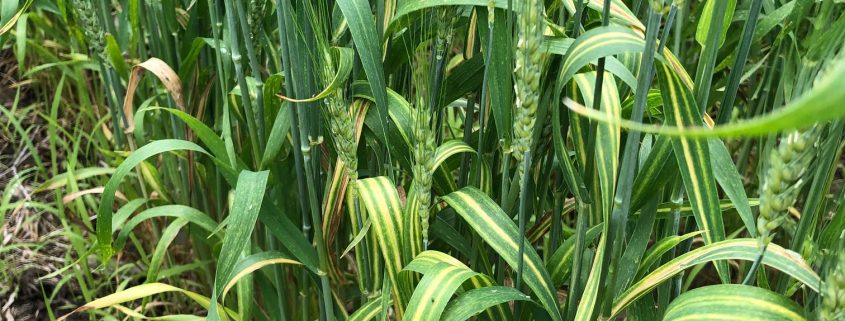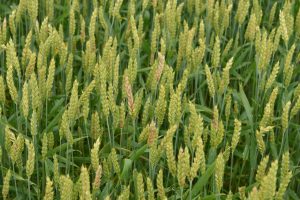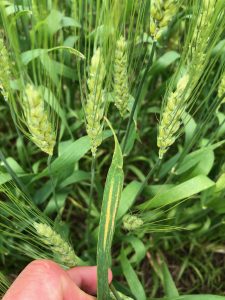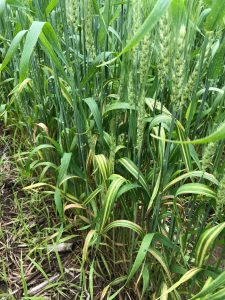Wisconsin Winter Wheat Disease Update – June 28, 2019
Damon Smith, Extension Field Crops Pathologist, Department of Plant Pathology, University of Wisconsin-Madison
Brian Mueller, Assistant Field Researcher, Department of Plant Pathology, University of Wisconsin-Madison
The Badger Crop Docs have been busy scouting production wheat fields and University of Wisconsin-Madison winter wheat variety trials and management trials around the wheat growing region of Wisconsin. Wheat heading and anthesis was very uneven this season. At several locations we visited, we could observe some varieties still in anthesis, while others had finished flowering for some time. Even within plot, variability existed. This variability has resulted in some difficulty in managing diseases.
Fusarium Head Blight Starting to Show Up
We are beginning to see Fusarium head blight (FHB or scab) showing up in many of the locations we have visited. More scab is apparent in the southern locations, especially in the Arlington area. As you might expect it does vary by variety, but in susceptible varieties incidence is running in the 5-10% range, with more expected to become apparent next week. The primary challenge managing scab this season, has been the uneven anthesis timing. Applications of fungicides for managing scab should begin at anthesis and continue until about 7 days after the start of anthesis. Uneven anthesis across a field can complicate the fungicide application timing, as some heads might be at the right growth stage while others might be still in the boot or already past anthesis. Multiple site-years of research in Wisconsin and the Midwest show that if fungicide is applied before anthesis or 10 days or more after anthesis, poor control of FHB will be achieved with a corresponding unacceptable reduction of vomitoxin. As we get closer to harvest, it will be important to scout your wheat for scab and determine how much damage is present. Careful harvest and cleaning will be necessary in these fields to make sure vomitoxin limits come in below thresholds where dockage and rejection occur for your elevator. Be sure you are familiar with your elevators dockage policies before hauling loads of grain. Each elevator has different rules and regulations.
What is the Situation with Rusts in Wisconsin on Winter Wheat?
We have observed very low levels of both leaf rust and stripe rust. Stripe rust has been observed at extremely low levels, at less than 5% incidence in only one variety at both the Fond du Lac and Sharon uniform variety trial locations. Leaf rust has been observed at similar levels on several varieties in the Arlington uniform variety trial. The late arrival of both of these rusts in Wisconsin will likely result in little yield impact. A fungicide application IS NOT recommended at this point in the season.
Tan Spot is Present At Many Locations
Tan spot has been observed in the lower canopy of wheat at all locations we have visited. The heaviest pressure has been at the Sharon and Arlington locations, with minimal pressure at the Fond du Lac and Chilton locations. Tan spot is remaining in the lower canopy in wheat treated with a fungicide. At Arlington, wheat in several research trials not treated with fungicide have significant tan spot on the flag leaves. If tan spot has reached the flag leaf at this point, yield may be negatively affected. With that said, a fungicide is NOT recommended at this time of season.
Cephalosporium Stripe Present in Sharon and Fond du Lac
We have also observed Cephalosporium stripe in both the Sharon and Fond du Lac uniform variety trials. This is a newer disease of winter wheat in Wisconsin, but has been observed over the past 2 seasons at the Fond du Lac location. This is the first year we have observed Cephalosporium stripe at the Sharon location. At this location, pressure is uniform and significant on several varieties. We observed incidence ranging from 0 to 90% depending on the variety. We believe that pressure is higher this year due to winter heaving and cool wet conditions this spring. No in-season management is available for Cephalospyrium stripe. However, noting which fields and locations in fields that have symptoms will help for future decisions about winter wheat management in those areas. Varieties with genetic resistance are available. Also longer rotations and better grassy-weed control can help reduce the severity of Cephalospyrium stripe. For more information about Cephalospyrium stripe CLICK HERE AND SCROLL DOWN TO THE CEPHALOSPORIUM STRIPE SECTION.








